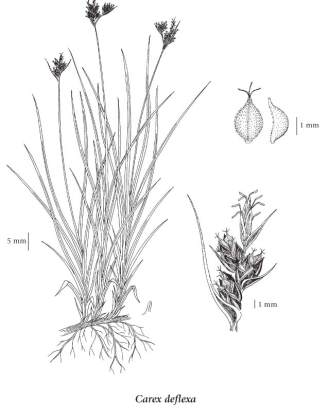Carex deflexa Hornem.
bent sedge (northern sedge; short-stemmed sedge)
Cyperaceae (Sedge family)
Introduction to Vascular Plants
bent sedge (northern sedge; short-stemmed sedge)
Cyperaceae (Sedge family)
Introduction to Vascular Plants
SUBTAXA PRESENT IN BC
Species Information
General:
Perennial, loosely tufted herb from slender, creeping, branched rhizomes; stems 5-25 cm tall, densely clustered, longer than or sometimes equalling the leaves, purple-tinged at the bases.
Leaves:
Sheaths tight, persistent; blades flat, channeled above, smooth or somewhat rough, borne on the lower 1/3 of the stem, 1-2 mm wide, the lower ones slightly reduced.
Flowers:
Spikes 2 to 6, the terminal one unstalked or short-stalked, 2-5 cm long, with male flowers, the lower spikes few-flowered, with female flowers, unstalked to short-stalked, 2 to 4 of these borne near the male spike and 1 or more usually borne near the bases of the stems, erect; bracts subtending the female spikes leaflike, sheathless or short-sheathing, shorter than to 4 times as long as the male spike, longer than the inflorescence, the upper bracts reduced.
Fruits:
Perigynia elliptical to broadly egg-shaped, 2-3 mm long, 0.5-1.5 mm wide, greenish to straw-coloured, convex, finely short-hairy, with 2 prominent marginal nerves, the bases short-stalked, the beaks short and inconspicuous to slender and 0.4-0.7 mm long, bidentate; female scales egg-shaped and pointed on the upper perigynia to broadly lanceolate and awned on the lower perigynia, usually shorter and somewhat wider than the perigynia, purplish-brown, with lighter midribs and translucent margins; stigmas 3; achenes 3-angled, smooth, 1.5-2 mm long.
Notes:
Closely related to C. rossii, these two taxa are sometimes considered conspecific. In that case C. deflexa (the oldest name in the complex) is used in a broad sense (e.g., Taylor 1983).
Illustration

If more than one illustration is available for a species (e.g., separate illustrations were provided for two subspecies) then links to the separate images will be provided below. Note that individual subspecies or varietal illustrations are not always available.
Illustration Source: The Illustrated Flora of British Columbia
Ecology
Ecological Framework for Carex deflexa
The table below shows the species-specific information calculated from
original data (BEC database) provided by the BC Ministry of Forests and Range.
(Updated August, 2013)
The table below shows the species-specific information calculated from
original data (BEC database) provided by the BC Ministry of Forests and Range.
(Updated August, 2013)
| Site Information |
Value / Class |
||
|
Avg |
Min |
Max |
|
| Elevation
(metres) |
1377 | 570 | 2393 |
| Slope
Gradient (%) |
46 | 9 | 91 |
|
Aspect (degrees) |
207 | 60 | 300 |
| Soil
Moisture Regime (SMR) [0 - very xeric; 4 - mesic; 8 - hydric] |
1 | 0 | 5 |
| Modal
Nutrient Regime
Class |
B | ||
| #
of field plots species was recorded in: |
10 | ||
| Modal
BEC Zone Class |
ESSF | ||
|
All BEC Zones (# of stations/zone) species was recorded in |
ESSF(6), ICH(1), PP(3) | ||
|
Source:
Klinkenberg 2013
|
|||